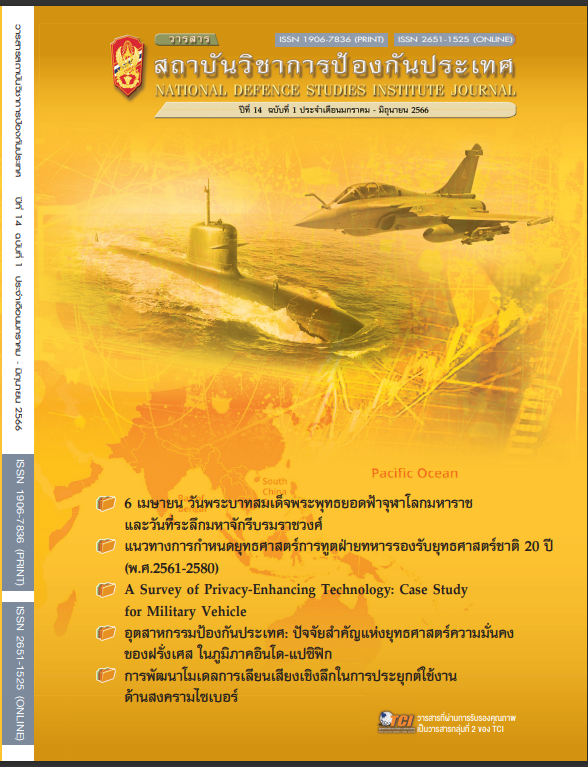Military Policy and Reaction of Thailand on Strategic Competitive of United State of America and People Republic Of China on Indo-Pacific Region
Main Article Content
Abstract
The geography of the Indo-Pacific Region is an area for fighting for leadership resulting in a complex relationship between states. Alliances are made to determine a cooperation framework. It is necessary for Thailand to adjust strategies to be in consonance with situations. There are both opportunities and challenges for Thailand to determine its roles and appropriate reactions.
The study shows that Thailand needs to operate its military strategy policy as a balancing military strategy by maintaining an appropriate balance for the nation’s benefits. The model used is that Thailand is located in a supportive geography. It is the center of connections and the core in ASEAN for an expansion of a military cooperation framework to countries of superpower. Thailand can combine forces with ASEAN neighbors and expand military relations with India and the Russian Republic to foster bargaining benefits. Meanwhile, it needs to build various relationships as well as maintain a friendly status in order not to be an enemy of either party. Independence must be practiced with closeness but with space in between. Military cooperation must be expanded in the aspect of joint and combined exercises.
Military diplomacy must be conducted to be impartial although being pressured to take a side. It should work as a bridge to connect the relationship between the United States of America (the US) and the People’s Republic of China (China). Intimacy shown must not create dissatisfaction with either the US or China. In other words, Thailand does not want either party to see Thailand as unfriendly but rather as being appropriately impartial on the global stage and the regional stage. Space must be maintained without being an instrument for the resistance of the other party. A side will not be taken and policy will not be slanted to one side or the other. Intimacy may be with China but the US must be close as well. The weight cannot be on either side. Maintenance of balance in this manner may result in not getting benefits from any side as it should have been. However, the country will not be greatly pressured from any side which may lead to advantages or disadvantages. This is not easy to conduct but it is necessary for the stability of the country and its own benefits.
Article Details

This work is licensed under a Creative Commons Attribution-NonCommercial-NoDerivatives 4.0 International License.
บทความ ภาพ ตาราง กราฟ ข้อเขียน หรือความคิดเห็นในวารสารฉบับนี้เป็นของผู้เขียนไม่ผูกพันกับสถาบันวิชาการป้องกันประเทศ และทางวิชาการแต่อย่างใดReferences
กระทรวงกลาโหม. (2560). ยุทธศาสตร์การป้องกันประเทศกระทรวงกลาโหม พ.ศ.2560-2579. กรุงเทพฯ. กระทรวงกลาโหม, สำนักนโยบายและแผนกลาโหม. (2560). แนวทางการเสริมสร้างความร่วมมือด้านความมั่นคงกับมิตรประเทศของกระทรวงกลาโหม 2560-2564. กรุงเทพฯ: สำนักนโยบายและแผนกลาโหม.
คณะกรรมการยุทธศาสตร์ชาติ. (2561). ยุทธศาสตร์ชาติ พ.ศ.2561-2580. กรุงเทพฯ: สำนักพิมพ์คณะรัฐมนตรี.
สุรชาติ บำรุงสุข. (2549). รัฐใหญ่แพ้สงครามเล็กอย่างไร.กรุงเทพฯ: สำนักพิมพ์สถาบันข่าวกรองแห่งชาติ.
Nye, J. S. Jr. (2007). Understanding International Conflicts: An Introduction to Theory and History. Crawfordsville: RR Donnelley and Sons Company.

